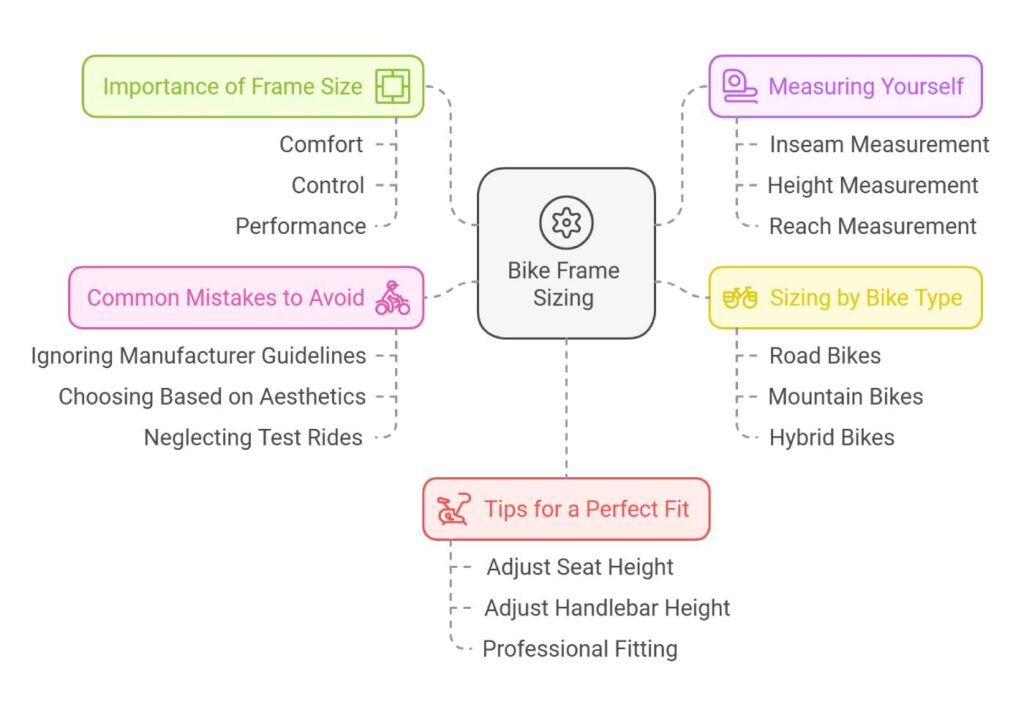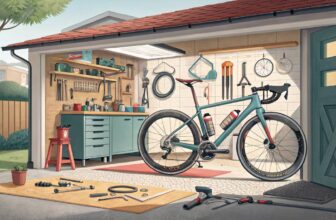Embarking on the journey to find your perfect bike? Imagine cruising effortlessly down your favorite trail, every pedal stroke feeling just right. The secret to that seamless ride lies in one crucial factor: bike frame sizing.
Whether you’re a seasoned cyclist or a newbie, selecting the right frame can transform your biking experience from frustrating to fantastic. At MyBikeReview.com, we’re here to guide you through the maze of measurements and specifications, ensuring your bike fits like a glove.
Dive into our comprehensive guide and unlock the key to comfort, performance, and endless cycling adventures!
Understanding Bike Frames
Why Picking the Right Size of Bike Matters
Getting the right size bike frame can make or break your riding experience. It keeps you comfy, helps you dodge most injuries, and lets you ride like a champ. Whether you’re into dirt paths, smooth roads, stunts, or zipping through town, finding that sweet spot in frame size is the secret sauce.
Now, adult bike frames get their size from the center part of the pedal thingy right up to where your seat sits. When you’re scouting for road bikes, you’ll notice sizes in centimeters, but mountain bikes roll with inches. This fancy measuring style keeps things tidy across different brands and makes choosing less of a headache.

Meet the Bike Family
Bikes come in all shapes and styles, each giving a nod to the kind of ride they’re best at. Knowing what’s what helps you zero in on your perfect match in the bike department.
Road Warriors
Road bikes are your go-to if you’re all about speed on those smooth streets. Think light, zippy frames, skinny tires, and handlebars that drop low for that aerodynamic edge. Sizes? Count ’em up in centimeters.
Off-Road Beasts
Mountain bikes pack a punch with sturdy builds, plump tires with grip, and fancy shocks to handle bumps and dips. Mountain bike sizes are usually tagged in inches for easy browsing.
The BMX Rebels
Small but mighty, BMX bikes are your pals for wild stunts, racing, and showing off your freestyle chops. With compact frames and 20-inch wheels, there’s plenty of control and no shortage of fun.
The City Slickers
Fixies, also known as fixed-gear bikes, keep things simple with one gear and a pedal action that’s always in sync with your wheels. Cruising the city or hitting the track? These are your trusty steeds.
Kiddo’s Fun Rides
For kids, bike sizes are measured by the wheels, not the frame. Smaller wheels mean easier control, so they won’t outgrow them too fast—sizes roll from teeny 12 inches for our tiniest bikers up to 24 or 26 inches for those juniors hitting their growth spurt.
Tailored for Her
Women’s bikes measure up much like men’s, meaning the same sizing charts apply. Yet, some tweaks exist, like designs that cater to comfort and style preferences unique to some women riders.
| Bike Type | What It’s Seen In | Usual Sizes |
|---|---|---|
| Road Warriors | cm | 48, 52, 56, 60 |
| Off-Road Beasts | in | 15″, 17″, 19″ |
| BMX Rebels | Wheel size | 20″ |
| City Slickers | cm | 50, 54, 58 |
| Kiddo’s Fun Rides | Wheel size | 12″, 16″, 20″, 24″ |
Choosing just right involves figuring out what feels best for you, how you like to ride, and maybe a chat with some experts. Get detailed with our bike size calculator and get the lowdown on bike geometry to make sure everything fits just how it should. And if you’re in a browsing mood, our bike comparison guide dishes out all the specs you’ll need to call the shots.
“A properly sized bike not only enhances your riding comfort but also significantly improves your performance and reduces the risk of injury.” – Cycling Expert
Measuring and Sizing Methods
Getting the perfect bike fit can make your rides a breeze and keep you in tip-top shape. Let’s pedal through the basics of measuring and picking the right frame for all you two-wheel enthusiasts out there.
Classic Road Bike Frame Sizing
To find your mojo with a classic road bike, you’ve got to zero in on the gap from the top of the seat tube to where the bottom bracket hangs out. Grab your ruler, and note down those digits in both centimeters and inches. This will guide you to your perfect ride fit.
| Height (ft/in) | Frame Size (cm) |
|---|---|
| 5’0″ – 5’3″ | 48 – 50 |
| 5’4″ – 5’7″ | 51 – 53 |
| 5’8″ – 5’10” | 54 – 56 |
| 5’11” – 6’2″ | 57 – 59 |
| 6’3″ and up | 60 – 62 |
Craving more nerdy details about bike geometry? Check out our piece on bike geometry explained for the full scoop.
Inseam Measurement Importance
Your inseam, or that floor-to-groin measure, is your secret weapon for finding the right frame. It keeps pesky pains away by ensuring a snug and comfy fit.
Here’s how to do it:
- Stand with your feet 6-8 inches apart.
- Jam a book between your legs, nice and high.
- Measure from the floor to the top of the book.
- Note it down in centimeters and inches to cover all bases.
In a hurry for a quick number crunch? Our bike size calculator has got you covered.
Women’s Specific Sizing
Ladies, listen up! Bikes for women are specially tweaked for generally longer legs and shorter torsos. They usually sport a shorter top tube and a comfy taller stack height.
| Height (ft/in) | Women’s Frame Size (cm) |
|---|---|
| 4’10” – 5’1″ | 42 – 44 |
| 5’1″ – 5’4″ | 45 – 47 |
| 5’4″ – 5’7″ | 48 – 50 |
| 5’7″ – 5’10” | 51 – 53 |
| 5’10” and up | 54 – 56 |
For the best feel, compare with women’s size charts. Want some deep dive details? Our compare bike specs article is just the ticket.
Getting your bike measurements right sets you up for rides that make you want to keep going. Newbie to the bike scene? Dip into our bike buying guides to get the lowdown before you shell out your hard-earned cash.
Factors Affecting Frame Selection
Choosing the right bike frame is like getting the perfect pair of jeans—comfort is key, and you want to look good cruising down the street. Here, we’ve gathered some tidbits to help you nail frame size for an awesome ride.
Height and Inseam Measurement
Getting the right bike fit starts with checking your height and inseam. Here’s the lowdown:
- Stand against a wall. Have someone mark the top of your noggin.
- Use this height, along with your inseam, to zero in on the right bike frame size. (Rinasclta Bike)
For adults, frame size gets measured from the center of the pedal crank to the top of the seat tube. Road bikes typically use centimeters, while mountain bikes are all about inches. For kids, wheel size does the trick—smaller wheels are easier to handle, but they might feel a bit cramped as they sprout like bean stalks.
| Bike Type | Frame Size | Height (cm) | Height (in) |
|---|---|---|---|
| Road Bike | 52 cm | 160-168 | 63-66 |
| Mountain Bike | 18 in | 170-178 | 67-70 |
| Kids’ Bike | 24 in | N/A | Up to 55 |
Impact of Frame Size on Comfort
Riding’s a whole lot better when you’re comfy:
- Riding a frame that’s way too big can make you feel like a human pretzel, leading to aches in your back, shoulders, and even your hands.
- Handling dynamics shift with frame size:
- A big frame makes for a steadier but less responsive ride.
- Smaller frames zip around but might get twitchy.
Top Tube Length Considerations
The top tube matters because it affects the biker’s posture:
- This controls how much you have to reach. Sure, you can mess around with the length of your bike stem, but ensure both feet hit the ground while stopped for full-on comfort and safety.
- If you mess up on top tube size, it’s not only uncomfortable but might cause some painful issues and affect bike handling. Frame size comes into play with how far you can reach comfortably, and the overall feel of the ride.
Scoping out these factors helps newbies buying their first bike, experienced cyclists looking to upgrade, and everyone in between. Enhance your biking experience—peep the bike buying mistakes article or get tailored advice with our bike size calculator.

Consequences of Incorrect Sizing
Picking out the right bike isn’t just about choosing the coolest color or a snazzy helmet. Getting the correct frame size is the real game-changer. A wonky size can mess with your health, comfort, and the whole biking vibe. Let’s dive into what can go wrong if you ride a wonky-sized bike.

Orthopedic Issues
Imagine stretching like a yoga class gone wrong. A too-big bike frame might have you doing just that, reaching for the handlebars and ending up with a sore back, achy shoulders, and grumpy wrists. These bad boys can even mess with your knees and hips if you’re not careful. A heavy dose of “ouch” that no one wants in their ride.
Handling and Maneuverability
Think of bike size as playing Goldilocks with handling. Too big, and your bike’s gonna handle like a bus; too small, and it’s like riding a jittery squirrel. Just right, and it feels like dancing on wheels. For bikers, especially the ones taking on bumpy trails or racing to the finish line, getting the size right means the bike listens and behaves just the way you’d want.
| Frame Size | Handling Characteristics |
|---|---|
| Too Big | Feels heavy, sluggish |
| Just Right | Smooth sailing, good control |
| Too Small | Jumpy, super touchy |
For more on this dance of bike control and handling tricks, hop over to our section on handling trade-offs.
Fitting Problems
So your bike doesn’t fit right, and now what? You might start fiddling with parts, like putting on a shorter stem to deal with an overgrown frame. But then, bam! Your bike turns twitchy, needing just a slight touch to zoom off in another direction.
These fitting spiders gonna nibble away at your comfort and stability. You might end up with a saddle that’s either sky-high or brushing the ground, making each ride more of a chore than fun.
Size really does matter. Whether you’re picking your first bike or leveling up to something fancier, put those measuring skills to work. Have a gander at our bike size calculator to keep your bike fitting game on point.
Dodging the sizing booby traps can save you a heap of trouble. For more insights and tailor-made advice, chat with the pros or scout our how to test ride bike guide for pro tips on nailing that perfect fit.
“Riding a bike that doesn’t fit can lead to chronic pain and diminish the joy of cycling, turning what should be fun into a frustrating experience.” – Professional Cyclist
Recommendations for Adjustments
Stem Length Tweaks
Ever felt like the handlebars on your bike are miles away or practically in your lap? Fiddling with the stem length could be your quick fix. Changing to a shorter stem pulls the handlebars in, boosting comfort and control. But hey, don’t go yanking those bars too close – this could make your bike respond to every twitch of the wrist, like a hyperactive squirrel. You’ll have agility, but you might have to trade off some steadiness. All these handlebar antics can be a bit of a balancing act.
Handling Give-and-Take
When it comes to bike frames, size matters, folks. Too big or too small, and you’re stuck in an endless cycle of backache and numb wrists. No one wants to feel like they just got stretched on a medieval rack after a ride.
Understanding how your bike’s frame size affects the way it moves is like having Jedi-level insight. If the frame’s off, it can mean constant shifting to find a comfy spot while riding. It’s not just about the look; it’s about fit and function. And remember – the correct seat tube length can make all the difference.
Seek The Pros
Got a buddy who knows their way around bikes? Lucky you! But when it comes to picking the perfect bike size, the pros have it dialed in. An expert’s touch can help tailor all things cycling to suit your style. First-time buyers or those jumping ship to a new bike will find this priceless.
Experts steer you clear of rookie mistakes, making sure the bike fits like a glove. For the nooks and crannies of measuring right, peek at our bike size calculator. Plus, don’t miss our handy advice on test riding bikes before you hit the road.
Adult Bike Sizing Guidelines
Getting the right bike size is like finding the perfect fitting pair of shoes—essential for a smooth and comfortable ride. Whether you’re new to cycling or swapping out your old wheels, we’ve got the lowdown on sizing for different types of bikes: road, mountain, and hybrid, plus the scoop on whether there’s any real difference between sizes for women and men.
Road vs. Mountain Bikes
Mountain and road bikes are like chalk and cheese when it comes to sizing. They’re built for different adventures, so finding the right fit is key to avoiding aches and pains—nobody’s up for a sore back, neck, or wrists, right?
- Road Bikes: These sleek speedsters are all about getting from A to B at lightning speed on paved roads. That means they come with larger frames and more stand-over height. The catch? Their sporty, aerodynamic position might not be the coziest for super long rides.
- Mountain Bikes: With smaller frames and a comfy upright position, mountain bikes are your go-to for conquering rugged terrain. They’re designed for agility and come with a lower stand-over height—great news if you’ve got shorter legs!
| Bike Type | Frame Size by Rider Height |
|---|---|
| Road Bike | Small: 5’3″ – 5’5″ | Medium: 5’6″ – 5’9″ | Large: 5’10” – 6’1″ |
| Mountain Bike | Small: 5’0″ – 5’5″ | Medium: 5’6″ – 5’9″ | Large: 5’10” – 6’2″ |
Hybrid Bike Sizing
Hybrids are the middle ground—the sensible shoes of the bike world. They take the best bits from both road and mountain bikes, making them super adaptable. For sizing, think Small, Medium, and Large—some brands go for inch measurements, but who needs that kind of stress?
- Small: For folks under 5’5″
- Medium: If you’re between 5’5″ and 5’9″
- Large: If you’re over 5’9″
Women’s vs. Men’s Sizing
So, is there a big difference in bike sizes for women and men? Not really. Most of the time, you can use the same charts to figure out what size you need for road or mountain bikes. Some brands make women-specific bikes with tweaks like shorter top tubes and narrower handlebars for comfort.
| Gender | Height Range for a Good Fit |
|---|---|
| Women | Small: 5’1″ – 5’4″ | Medium: 5’5″ – 5’8″ | Large: 5’9″ – 6’0″ |
| Men | Small: 5’4″ – 5’7″ | Medium: 5’8″ – 5’11” | Large: 6’0″ – 6’3″ |
Curious about more bike-fitting tips and size differences? Head over to our articles on bike size calculator, bike geometry explained, and bike size conversion. Thinking about where to grab your next bike? Check out where to buy bikes online and get the scoop on bike price guide for a no-surprises approach to bike shopping.
Bike Sizes by Type
Getting a bike that perfectly matches your size is like finding a pair of shoes that fit just right. Comfort, control, and joy in riding all start with the right frame size. And trust me, it’s more vital than you might think.
Importance of Frame Size
The frame size could make or break how a bike fits you to a tee. Now, for those adults out there, grab a measuring tape and check out sizes from the heart of the crank axle to where the seat post peaks. When your bike fits like a glove, you’ll steer it better, slash the odds of wiping it out, and ride like a breeze. But mess up the size and you could end up with achy joints and a not-so-cozy ride.
The Simple Sizing Formula
Different bikes come with their own math for figuring out the best frame size based on how long your legs stretch. Here’s the lowdown:
| Bike Type | Sizing Formula |
|---|---|
| Mountain Bike | Leg Inseam * 0.58 |
| Road Bike | Leg Inseam * 0.70 |
| City Bike | Leg Inseam * 0.66 |
These handy dandy formulas give a good ballpark figure for choosing a size. So, if you’re blessed with legs that boast a 30-inch inseam, a mountain bike frame buzzing around 17.4 inches should do the trick (30 * 0.58).
Finding Your Riding Groove
Picking a frame size isn’t just about numbers; it’s about finding your own groove. Let’s break it down:
Dynamic Riding Style
If you’re all about speed and swerving past the crowd, a smaller frame is your bestie. It’s zippy, quick on its feet, and great for those who dodge city traffic or love a good race.
Comfort Riding Style
On the flip side, if cruising in comfort is your prime focus, aim for the larger frame. It lays back, easing the strain on your body, perfect for soaking up miles or laid-back cycling joyrides.
| Riding Style | Preferred Frame Size |
|---|---|
| Dynamic | Smaller Frame |
| Comfort | Larger Frame |
If you’re sizing up for the first time, upgrading, or buying for a pal or your kid, let these pointers and a sprinkle of expert advice steer you right. Pick the right size and you’re in for a sweet ride. Want a customized size suggestion? Our bike size calculator has got you covered.
Grasping the ins and outs of bike frame sizing can make a real difference in your choice and satisfaction. To dodge classic bike buying blunders, take a gander at our articles on comparing bike specs and get the 411 with bike geometry explained.
Practical Sizing Tips
Seat Tube Length Comparison
So, you’re in the market for a new set of wheels or ready for an upgrade, huh? It’s time to get cozy with the whole seat-tube-length gig, a thing that’ll make or break your bike pick. Just find the tip-top of that seat pipe, locate the heart of your pedal zone (a.k.a., the bottom bracket), and measure the stretch in between. Keep those measurements handy in both centimeters and inches, saving you a double take later on.
| Measurement Type | Distance (cm) | Distance (in) |
|---|---|---|
| Top of Seat Tube to Bottom Bracket | 50 | 19.7 |
Frame Size Calculation Methods
Let’s keep it straight and simple, like riding on a Sunday morning. Grab a tape, measure your height and that inseam of yours (you know, that line from your heel up), and match it up with a frame size. It’s a bit like matchmaking for bikes without the awkward first date! Here’s a cheat sheet to make this less of a game of guesswork:
| Rider Height | Leg Inseam | Recommended Frame Size |
|---|---|---|
| 5’0″ – 5’3″ | 25″ – 28″ | 48 – 50 cm |
| 5’4″ – 5’7″ | 27″ – 30″ | 51 – 53 cm |
| 5’8″ – 5’11” | 29″ – 32″ | 54 – 56 cm |
| 6’0″ – 6’3″ | 31″ – 34″ | 57 – 60 cm |
| 6’4″ – 6’7″ | 33″ – 36″ | 61 – 64 cm |
Still not sure? Give a bike size calculator a whirl to nail that perfect fit.
Riding Style Considerations
You’re not just buying any bike; you’re buying your bike. Figure out if you’re a zoom-through-the-city-ninja or a laid-back-long-distance explorer. A smaller frame might be your best buddy for weaving through traffic like a breeze, while a slightly larger one lets you kick back on those epic Sunday pedal fests.
When settling on that two-wheeler:
- Mull over those frame size calculations
- Peek at used bike inspection tips
- Size up different bike models
- Snooze your way through bike reviews and set up brand comparisons for the ultimate pick.
Need more tailored guidance? Checking out the lowdown on testing rides can crown your decision-making process.
Conclusion
Choosing the right bike frame size is more than just a numbers game; it’s about harmonizing your body’s unique dimensions with your cycling ambitions. A well-fitted bike ensures comfort, boosts performance, and minimizes the risk of injuries, allowing you to fully enjoy every ride, whether you’re tackling rugged trails or cruising city streets.
By understanding the different sizing metrics for various bike types and accurately measuring your height and inseam, you lay the foundation for an optimal biking experience.
Remember, it’s not just about finding a frame that fits today but one that accommodates your growth and evolving riding style.
Don’t hesitate to seek expert advice or use our comprehensive bike size calculator to fine-tune your choice. Embrace the journey of finding your perfect fit, and watch as your cycling adventures become smoother, more enjoyable, and endlessly rewarding.
At MyBikeReview.com, we’re committed to helping you pedal toward the perfect ride with confidence and ease.
FAQs
What is the most important measurement for determining bike frame size?
The most crucial measurement is your inseam length, which, along with your height, helps determine the appropriate frame size for optimal comfort and performance.
How do bike frame sizes differ between road and mountain bikes?
Road bikes typically use centimeters for frame sizing, focusing on longer, lighter frames for speed, while mountain bikes use inches, emphasizing sturdier builds for handling rough terrains.
Can I adjust my bike frame size if it’s not a perfect fit?
Yes, certain adjustments like changing the stem length or seat position can help fine-tune the fit, but it’s best to start with the correct frame size to ensure overall comfort and performance.
Is there a difference in bike sizing for men and women?
While most sizing charts are similar, women’s bikes often have specific adjustments like shorter top tubes and narrower handlebars to accommodate different body proportions and enhance comfort.
What are the consequences of riding a bike with the wrong frame size?
Riding a bike that’s too big or too small can lead to discomfort, poor handling, increased risk of injuries, and decreased overall riding enjoyment.
Final Thoughts
Selecting the right bike frame size is the foundation of a rewarding and enjoyable cycling journey. It’s not just about fitting into a bike; it’s about finding a partner that moves with you, supports your goals, and enhances every ride.
By taking the time to measure accurately, understand your body’s needs, and consider your riding style, you set yourself up for countless hours of smooth pedaling and adventure.
Remember, the perfect fit can transform your cycling experience, making it safer, more comfortable, and more fun. Don’t rush the process—use the tools and resources available, seek expert advice when needed, and trust your instincts.
At MyBikeReview.com, we’re dedicated to helping you pedal confidently into your next biking chapter with the perfect frame size tailored just for you.
Key Tips for Choosing the Right Bike Frame Size
- Measure Your Inseam: Stand against a wall with your feet shoulder-width apart and measure from the floor to your crotch to determine your inseam length.
- Consider Your Riding Style: Different biking activities (road, mountain, BMX) require different frame geometries and sizes for optimal performance.
- Use a Bike Size Calculator: Utilize online tools to input your measurements and receive size recommendations tailored to your specific bike type.
- Test Ride Multiple Bikes: Whenever possible, test ride bikes in various sizes to feel the differences in comfort and handling firsthand.
- Adjustable Components: Remember that handlebars, stems, and seat posts can be adjusted to fine-tune the fit, but starting with the correct frame size is crucial.
- Consult with Experts: Visit a professional bike shop for personalized fitting advice and recommendations based on your unique body proportions and cycling goals.
- Account for Future Growth: If purchasing a bike for a child, choose a frame size that allows for some growth to extend the bike’s usability.
- Check Manufacturer’s Sizing Charts: Always refer to the specific brand’s sizing guidelines, as sizes can vary between manufacturers.
- Prioritize Comfort Over Trends: Choose a frame size that feels comfortable and suits your needs rather than following the latest bike size trends.
- Reassess Your Fit Regularly: As your fitness level and riding habits change, periodically check and adjust your bike fit to maintain comfort and performance.
Recommended Biking Products and Accessories
- Bike Size Calculator by MyBikeReview.com
- An online tool to input your height and inseam measurements to receive personalized bike frame size recommendations for various bike types.
- Flexible Measuring Tape
- A durable, flexible tape measure designed for accurate body measurements, essential for determining your inseam and overall height for bike sizing.
- Professional Bike Fit Services
- Available at local bike shops, these services provide expert assessments and adjustments to ensure your bike fits your body perfectly, enhancing comfort and performance.
- Adjustable Stem
- Upgrade to an adjustable stem to fine-tune handlebar height and reach, allowing for a more customized fit without changing the entire frame.
- Seat Post Extenders
- These extensions can help adjust saddle height for a better fit, providing additional comfort during rides by ensuring the saddle is at the optimal level.
- Bike Geometry Books
- Comprehensive guides like “Bike Fit: Optimizing Your Bike to Your Body for Comfort, Speed, and Efficiency” by Phil Burt provide in-depth knowledge on bike fitting and geometry.
- Height and Inseam Measurement Guides
- Laminated reference cards or printable guides to keep your measurements handy when shopping for new bikes or making adjustments.
- Saddle Adjustment Tools
- Tools such as Allen wrenches and saddle clamps allow you to easily adjust saddle position and angle for improved riding posture and comfort.
- Cycling Shorts with Padding
- While not directly related to frame sizing, quality padded shorts can enhance comfort, especially when adjusting to a new bike size.
- Online Bike Fit Courses
- Educational courses or webinars that teach the fundamentals of bike fitting, helping you understand how to achieve the perfect fit independently.




